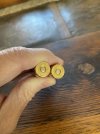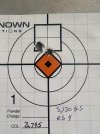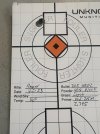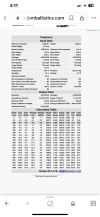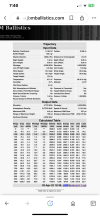nralifer
Well-Known Member
I got some comparative testing to demonstrate the effect of BC in the 308 Win (24" Bartlein, Lapua Palma SRP brass, 1x firing full length sized, CCI 450 primer).
Used a Lab Radar and measured the G7 BCs from the radar data.
Load was 49.5 gr Leverevolution with both bullets loaded 0.025"off lands.
Conditions 57F, 33% humidity, 28.25 inHg
Velocity, energy and BC calculations using JBM Trajectory and JBM BC (Velocities) calculators
Bullet #1 150.4 gr average
MV= 3035 fps average of 5 shots ES=9 fps
G7BC=0.184 average 5 shots
At 600 yds 1727 fps, 996 ft-lbs
Bullet #2. Badlands 150 gr BD-2 151gr average
MV=3089 fps average of 5 shots ES=7 fps
G7BC=0.266 average of 5 shots
At 600 yds 2131 fps, 1523 ft-lbs
Results show several things
1) bullet #1 had multiple bands to redice bearing surface and claims this reduces friction in the barrel, however when shot from the same gun, with the same powder charge and the same jump using the same brass and powder and loaded to a low ES in velocity it had an MV 53 fps slower than the BD-2 which was slightly heavier. The take home message is that multiple ridges along the bearing surface to cut down surface area contact with the barrel don't necessarily guarantee a higher MV at equivalent powder charges.
2) The velocity and energy differences at 600 yds under the same atmospheric conditions are large. The Badlands BD2 retained 52% more energy than Bullet #1 which was just under 1000 ft-lbs compared to the BD2 which retained 1523 ft-lbs. the speed difference was 404 fps in favor of the BD-2 bullet. The take home message is that BC matters, and the further out you go the more it matters. The BD-2 bullet reaches the same energy level as Bullet #1 at 900 yds rather than 600.
The picture below shows no significant primer flattening or ejector marks in either bullet load. Bullet #1 case is on the left, BD-2 case on right. There is some cratering in both but this is common with Savage actions.
Used a Lab Radar and measured the G7 BCs from the radar data.
Load was 49.5 gr Leverevolution with both bullets loaded 0.025"off lands.
Conditions 57F, 33% humidity, 28.25 inHg
Velocity, energy and BC calculations using JBM Trajectory and JBM BC (Velocities) calculators
Bullet #1 150.4 gr average
MV= 3035 fps average of 5 shots ES=9 fps
G7BC=0.184 average 5 shots
At 600 yds 1727 fps, 996 ft-lbs
Bullet #2. Badlands 150 gr BD-2 151gr average
MV=3089 fps average of 5 shots ES=7 fps
G7BC=0.266 average of 5 shots
At 600 yds 2131 fps, 1523 ft-lbs
Results show several things
1) bullet #1 had multiple bands to redice bearing surface and claims this reduces friction in the barrel, however when shot from the same gun, with the same powder charge and the same jump using the same brass and powder and loaded to a low ES in velocity it had an MV 53 fps slower than the BD-2 which was slightly heavier. The take home message is that multiple ridges along the bearing surface to cut down surface area contact with the barrel don't necessarily guarantee a higher MV at equivalent powder charges.
2) The velocity and energy differences at 600 yds under the same atmospheric conditions are large. The Badlands BD2 retained 52% more energy than Bullet #1 which was just under 1000 ft-lbs compared to the BD2 which retained 1523 ft-lbs. the speed difference was 404 fps in favor of the BD-2 bullet. The take home message is that BC matters, and the further out you go the more it matters. The BD-2 bullet reaches the same energy level as Bullet #1 at 900 yds rather than 600.
The picture below shows no significant primer flattening or ejector marks in either bullet load. Bullet #1 case is on the left, BD-2 case on right. There is some cratering in both but this is common with Savage actions.

